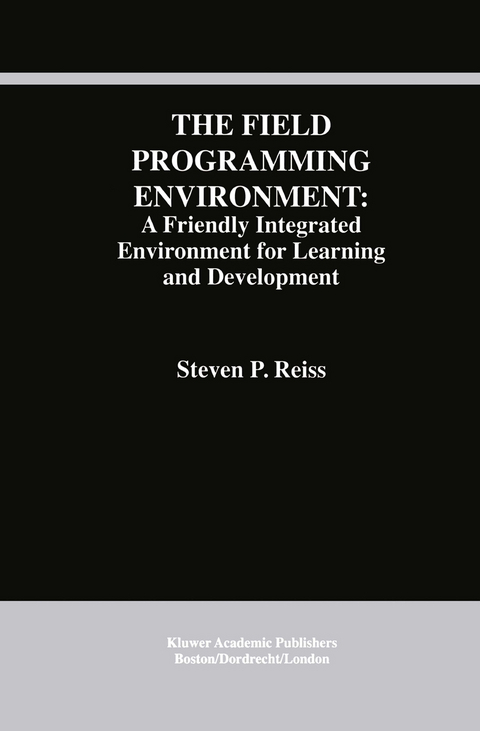
The Field Programming Environment: A Friendly Integrated Environment for Learning and Development
Springer-Verlag New York Inc.
978-1-4613-5930-2 (ISBN)
The book will be valuable for those interested in the development of programming tools and environments, as well as serious users of programming environments. It will also be of interest to anyone undertaking a large software project, both by introducing the software tools needed to work on such a project and by demonstrating the concepts of message-based integration which can be applied to a variety of domains.
1 Integrated Programming Environments.- 1.1 What Is a Programming Environments.- 1.2 Classification of Environments.- 1.3 Objectives in Building Field.- 1.4 Integration Strategies.- 1.5 Overview of the Field Environment.- 2 The FIELD Integration Mechanism.- 2.1 The Message System.- 2.2 Pattern Matching.- 2.3 Message Types.- 2.4 Message Groups.- 2.5 Other Message Facilities.- 2.6 The Msg Program Interface.- 2.7 Comparison To Other Implementations.- 3 The FIELD Policy Service.- 3.1 The Policy Concept.- 3.2 Policy Language Concepts.- 3.3 Sample Policy Programs.- 4 The FIELD Debugger.- 4.1 Overall Debugger Organization.- 4.2 The Message Interface.- 4.3 Messages Generated by the Debugger.- 4.4 The Textual Command Language.- 5 Cross-Referencing in FIELD.- 5.1 The Overall Approach.- 5.2 The Cross-Reference Database System.- 5.3 The Cross-Reference Scanners.- 5.4 The Cross-Reference Server.- 6 FIELD Services.- 6.1 Configuration and Version Control.- 6.2 Program Profiling.- 6.3 Execution Monitoring.- 7 The Brown Workstation Environment.- 7.1 History of Bwe.- 7.2 Basic Bwe Components.- 7.3 Structured Graphics Display.- 7.4 Resource Management.- 8 The Annotation Editor.- 8.1 Annotations.- 8.2 Integrating Annotations and Messages.- 8.3 Permanent Annotations.- 8.4 Annotation Editor Interface.- 9 The Debugger Interface.- 9.1 Overview.- 9.2 DBG.- 9.3 Viewers of Debugger Information.- 9.4 The User Input-Output Viewer.- 10 The Interface for Cross-Referencing.- 10.1 Defining Standard Queries.- 10..2 Query Processing.- 10.3 Interacting with Other Tools.- 11 The Call Graph Browser.- 11.1 Organizing the Data.- 11.2 Browsing Options.- 11.3 Information Window.- 11.4 Animating the Call Graph.- 11.5 Interacting with the Environment.- 12 The Class Hierarchy Browser.- 12.1 What to Display.- 12.2Displaying Large Hierarchies.- 12.3 Class and Member Information.- 12.4 Interacting with the Class Browser.- 13 The Interface to UNIX Profiling Tools.- 13.1 Displaying the Performance Data.- 13.2 Interacting with Xprof.- 14 Configuration and Version Management.- 14.1 Obtaining the Information.- 14.2 Displaying the Dependency Graph.- 14.3 Browsing Options and Commands.- 14.4 Interacting with Other Tools.- 15 Data Structure Display.- 15.1 Getting the Information.- 15.2 Default Display Definitions.- 15.3 User-Defined Display Definitions.- 15.3.1 The APPLE Editor.- 15.3.2 The APPLE User Interface.- 15.4 Examples of Mapping Definitions.- 15.5 Editing Data Structures Graphically.- 16 Monitoring Program Execution.- 16.1 Heap Visualization.- 16.2 Input/Output Visualization.- 16.3 Performance Visualization.- 17 The Control Panel.- 17.1 Defining the Control Panel.- 17.2 Window Management.- 17.3 Common Utilities.- 17.4 Standard Button Commands.- 18 Retrospective.- 18.1 Messaging.- 18.2 General Structure.- 18.3 Graphical Interfaces.- 18.4 Editing.- 18.5 Debugging.- 18.6 Program Database.- 18.7 Experience with the Environment.- 18.8 Conclusion.
| Reihe/Serie | The Springer International Series in Engineering and Computer Science ; 298 |
|---|---|
| Zusatzinfo | XXIV, 286 p. |
| Verlagsort | New York, NY |
| Sprache | englisch |
| Maße | 155 x 235 mm |
| Themenwelt | Mathematik / Informatik ► Informatik ► Programmiersprachen / -werkzeuge |
| Mathematik / Informatik ► Informatik ► Software Entwicklung | |
| Informatik ► Theorie / Studium ► Compilerbau | |
| ISBN-10 | 1-4613-5930-9 / 1461359309 |
| ISBN-13 | 978-1-4613-5930-2 / 9781461359302 |
| Zustand | Neuware |
| Informationen gemäß Produktsicherheitsverordnung (GPSR) | |
| Haben Sie eine Frage zum Produkt? |
aus dem Bereich


